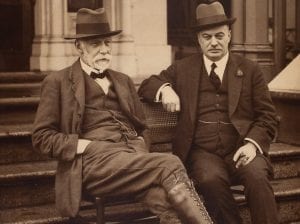The Martyr Problem Among Nonprofits
Nonprofits tend to be excessively humble, and that’s a dangerous virtue.
Several years ago, I was asked to consult on a nonprofit’s capital campaign. My principal task was to help imagine the campaign’s concept, its rationale, its poetry. In other words: what made the organization essential and why sustaining it was essential to the world at large.
During a meeting that followed months of concept development, the executive director confessed to me that ultimately he didn’t believe the organization “did” anything. At first I thought this was his fatigue talking, but he continued by explaining that the organization was not an active force in transforming lives—nor was it meant to be.
Its mission was more indirect, more detached. It existed, he said self-deprecatingly and yet somehow stridently, to facilitate only the “possibility” of change.
I was taken aback. Not just because this was unlikely to open minds or wallets but, more importantly, because I disagreed with his argument. Mightily.
Leaving my dispassion as a consultant aside, I said that I believed his organization offered programs that foster curiosity and integrity, safeguard reasoned discourse, and promote critical reflection on contemporary issues.
For a society, an era, and a political climate that privileges the glib and false over the thoughtful and true, I regarded his organization to be a bulwark, as vital to the future of our nation’s well-being as the “possible” cancer cure is to the individual’s.
Now it was the director’s turn to look at me with surprise.
As someone who has worked and consulted for nonprofits for more than two decades, I wish I could say this story was the exception. Unfortunately, it is in my experience the rule.
More and more, clients I encounter across the nonprofit spectrum, who may come to me with different needs, have a similar problem at their cores: a lack of pride.
Recently a university official told me that even the word “transformation” was one the institution would never use.
“It’s just not in this school’s dictionary,” a woman in development warned.
That gave me pause since the university, like many of its kind, asks young people to spend four years challenging their minds and better understanding their own characters. No transformation? Really?

Nonprofits have reverted to an understandable, if strange, sort of hope: to fulfill their missions without the risk of offense but, because of that, without much conviction either.
Unlike the corporate clients with whom I’ve worked, the well-meaning people I’ve met at nonprofits seem to believe pride is a vice.
These organizations prefer to approach the public, donors, and themselves with what might charitably be spun as humble detachment.
Because my work as a communications professional is about articulating the necessities of their work, that humility and detachment are a problem. For me, to a degree, but much more troublingly for them.
In many ways, the “modesty problem” among nonprofits is logical.
The staff members who toil at these institutions, particularly those with intellectual or cultural missions, are the people most conscious of the forces aligned against them: self-appointed critics who have made for-profit careers out of dismissing the examined life as arrogant, elitist, and snobbish.
Nonprofits have become so exhausted and intimidated by these charges that their pride has suffered.
In the process, they have reverted to an understandable, if strange, sort of hope: to be left alone to do their work under the radar. To fulfill their missions without the risk of offense but, because of that, without much conviction either.
Don’t get me wrong: Modesty can be a virtue. In a self-aggrandizing world, a humbling focus on service can be refreshing.
But since the culture wars have raged over the last thirty years and corporate America has become more self-serving—its bottom-line values influencing what Americans value—there has never been a more important time for the prideful nonprofit.
Really, what nonprofit diffidence has done is create a vicious cycle. Anxieties about perceptions of elitism and snobbery—qualities that these days have become perversely associated with altruistic motives—have made nonprofit leaders fearful of speaking full-throated about the power of their purpose, making those purposes seem smaller, less meaningful, and less applicable to everyone in the public sphere.
Browbeaten and marginalized, many nonprofit leaders decide to turn and speak only to their choirs, believing only they can understand, which further alienates their work from the common purpose they purport to serve. All this ironically confirms the charges of elitism and irrelevance, making these organizations complicit in their own obsolescence.
Can we honestly act surprised when private or public money declines if the nonprofits that advocate for these causes appear to be what their critics claim: removed and therefore inanimate in many people’s lives?
In reality, culture, ideas, and the promotion of thought are anything but inconsequential. And they are certainly not a luxury of and for the few.
In my years working with institutions devoted to these principles—museums, arts organizations, foundations, libraries, higher education—I have found them to be our last great hope for an absolutely critical human need: to occupy, if even for a few moments, the lives of others, and in doing so understand experiences and insights that are not our own.
What these organizations offer are pathways that take us out of ourselves; pathways we cannot generate ourselves; pathways that enlarge us. Taking those pathways is a step universal to all journeys of progress. And those journeys are what make us compassionate, innovative, nobler—they’re what make us better.
Couldn’t we all agree that what our increasingly self-absorbed world may need most is precisely the self-abandoning, enlightening, and, yes, transformative perspective these institutions supply? I can think of few missions that are more high stakes than these.
These missions are, in fact, the missions that make all other missions possible: Cancer research becomes that much more critical to support if we read the memoir of someone stricken.
Freedom from injustice is that much more necessary to advance if we listen to a talk by someone who can explain its roots, patterns, and consequences. The environment becomes that much more urgent to preserve if we experience an exhibit portraying its devastation.
Cause enough for pride? Absolutely. But the advantages of pride extend beyond conveying missions or enticing donors. Pride is also key in changing the internal cultures of nonprofits, which may be where its resurgence can do the most good.
Pride can reinvigorate a nonprofit’s work by requiring the group to consider whether its program truly meets its responsibilities to the wider world. How so?
Pride’s parent is authenticity, so only those who engage in a sincere evaluation about whether they are who they say they are can actually be proud. In short, an organization’s pursuit of pride is a good indicator of the level of integrity it possesses, and vice versa.
Along those lines, pride also invites change and encourages risk. After all, when one is confident, one fears less, and fearing less rids organizations of airless and limiting monotonies.
Pride even plays a key role in hiring. The nonprofit world is by and large a history of dedication to thankless causes, but in embracing that spirit of martyrdom too fully, employees can adopt inferiority complexes. Many nonprofit workers come to believe they are not as talented as people who have chosen to be elsewhere, somewhere the culture may outwardly value more—somewhere in the for-profit world. What’s more insidious is how this attitude gives rise to a belief that anyone looking to join their organization is likely to be less capable, too.
In the aggregate, that kind of collective martyrdom—however false—can lead to a very real ineffectuality. Because if a calling to service means subservience, why would talent ever be tempted to join or encouraged to stay once it arrived? In reasserting pride alongside service, nonprofits ensure they will attract the best and brightest.
Since so much of philanthropy is defined by preserving or preventing something, it is poetic that these days nonprofits have arrived at their own mission-critical moment. They must prevent their own irrelevance by preserving their pride. That’s a mission all missions have in common and one that’s worth—and dependent upon—every prideful assertion charities can make.























